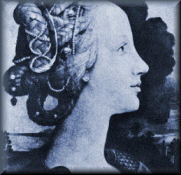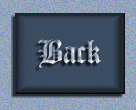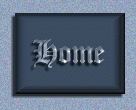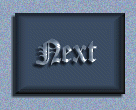
Scroll down to begin your review of Elizabethan Fashions!


 Elizabethan Fashions
Elizabethan Fashions
In the Elizabethan Era, jewelry and clothing were very flashy and elaborate. Embroderies, gold and silver lace, jewels and rare furs were used as trimmings on expensive clothing. Fabrics used for elegant clothes were silks and velvets.
Italian and Spanish fashions with the shoulder puffs, long-waisted look, and high collars were followed by English nobility. Long fitted hose made out of yarn or silk, trunks that had been stuffed or padded, and a rich fabric jacket, called a doublet, worn over a silk shirt were worn by men. A full, knee-length cloak, called a gown, would be worn over this. Leg of mutton was a certain kind of padded sleeves, often covered with jewels. Usually, to make the basic dress look different, they would remove the sleeves and put on a new pair.
The women wore a hooped petticoat covered with taffeta, called a farthingale, under their skirts. The farthingale was made the fashion all over Europe by a Spanish Princess. If you put a different farthingale under the same dress, it gave it a whole new look. Extra petticoats and sometimes dresses with deep pockets were worn during the winter. In the pockets they would put rodents and the body heat from the rodents would keep the lady warm. Extra shirts and heavier gowns or capes were worn by men.
Many people wore ruffs at the neck. They were starched and pleated until stiff and made of a heavy fabric. A law was made saying that ruffs couldn't be too large, but no one obeyed it. The ruffs got so large that the person wearing it would have trouble turning his or her head.
To attain the slender, long-waisted look, both men and women wore corsets. Many people had difficulty bending over because the corsets were made of wood, metal, or whalebone and were very stiff.
Both men and women wore gloves and hats, women's were often jeweled and lined with fur. At this time, cleanliness was not all that high of a priority, so gloves would keep them from touching other people's dirty hands. Hats were very elaborate and were worn indoors and outdoors. Men and women put jewels, feathers, and other decorations on their hats. It was customary, back then, for men to take their hats off when greeting a lady, so they were always careful to turn their hat so the lady couldn't see the inside band, which was usually quite dirty.
Fans were jeweled or mirrored and were carried by women. Just as they were for decoration, they were also used to keep offensive odors away. In many pictures, you can see Queen Elizabeth with a pomade ball hanging from her waist. It too, was to keep offensive odors away. Body odor could get quite bad then, because many people did not bathe. Queen Elizabeth would wave the pomade ball between herself and someone if their body odor became too offensive.
Pointed shoes were favored by ladies and women often dyed their hair. Make-up was worn by both men and women. In the sixteenth century, the white of all cosmetics came from lead, and that presented a health problem. Sometimes the use of cosmetics produced deadly results, such as lead poisoning. William Shakespeare's play The Twelfth Night referred to a custom called cross-gartering which was considered an extravagant show of fashion. In that play, men wore garters above and below the knee.
The best clothes belonged to the Queen. The coronation gown Queen Elizabeth wore weighed five hundred pounds. She had to rely on members of the court to help her walk in it because it was so large. Many trade unions gave the Queen beautiful dresses decorated with fine jewels, because they wanted her favor. After wearing the dress only once, her ladies-in-waiting would remove the jewels from the fabric. Profits made from the sale of the jewels were given to charities. When she died, Queen Elizabeth had more than two thousand dresses.
The merchants of the day dressed more plainly. To go over a farthingale, a woman would have one or two long dresses. A calf-length cloak, usually made out of wool, trimmed with fur and sashed at the waist was usually worn by her husband.
Both the rich and the poor got along without underwear. Most people wore a chemise, which was a tight fitting long-sleeved undergarment. The poor mainly wore rags. For the poor, winter was usually the harshest time, many froze to death due to lack of food and proper clothing.
 Women's Fashions
Women's Fashions
Back then, women did just about anything to make their waists smaller, or at least to appear smaller. In order to get rid of folds and creases, bombast stuffing was used in doublets and hose to make them swell out. "it consisted of rags, flock, horsehair, cotton, or even bran - although bran sometimes led to disaster, since the bran ran out if the clothes got torn. The bombasting of the doublet over the chest and the stuffing of breeches naturally made the waist seem smaller, and the effect was increased by the use of tight-lacing."(Springfield)
To show status in society, women would wear ruffles. This was known as "heirarchical element in dress." (Springfield) In the 1500's the ruffle grew. To form a ruffle, a string was pulled through the upper edge of the shirt. Another element noted when women wore them was called the "Seduction Principle," used to show off a woman's charms by "open[ing] the ruffle in front to expose the bossom, and to allow the ruffle to rise in gauze wings at the backof the head." (Springfield) This fashion was shown in many portraits of Queen Elizabeth.
In Elizabethan times, gowns had a new style of sleeve. Jewel fasteners held a complicated collection of small pieces for the sleeves. Vast quantities of fabric were made for the under-sleeve to give it a puffy style.
In that time, the dress was actually very simple, although it seems complicated now. The shift was the first layer and was like a man's shirt. After that, they would put on one or two petticoats. The outer petticoat was a different color than the gown and was pleated.
The gown, with it's full, trailing skirt, was put on next. To make walking easier and to show the lining, the train was sometimes lifted and fastened to the girdle at the back. To give the skirts shape, many women wore hip pads. Sometimes the gown was laced in the back, or fastened in the front. In the front, the neck of the dress was square and low. The back was either V-shaped or U-shaped. Ruffles, or ruffs, were supported by a wire frame around the neck of the dress and usually had silver, gold, or silk thread fixed at the back of the neck.
The sleeves were usually bell-shaped. To form immense cuffs, many turned back the lower edge of the sleeve several inches. This displayed the under-sleeve, and revealed the lining which was attached to the elbow or the shoulder. Plain full sleeves were very popular, as were tied, slashed or split sleeves.
To avoid the sun, and unpleasant people, women carried black velvet masks when walking long distances. Almost every woman carried a small hand mirror.
The wealthy were spending large amounts of money on clothes at the beginning of the sixteenth century. At this time, pride in clothing meant a great deal to them. Many women tried to copy the fashions of the wealthy. Most lower class people tried to raise their social status by following the fashions of the wealthy people.
The costumes worn in those years were the most colorful seen throughout history. The things that distinguished the Elizabethan women were their great beauty and their bright clothing. "Today, we admire this era as one of the most brilliant and exciting in fashion history." (Springfield)
To acheive the latest look in hairstyles, Elizabethan women went to extremes. The favorite hue was blonde, so many woment dyed their hair. Women believed that the sun added a golden tint, so many days were spent sitting outside in the sun. Women wore hats with their hair spread over the brim and no crown. When they dyed their hair, the wearer was protected from the sun by the brim. White and yellow silk, or peasants hair made up false hair, which was used in great quanitites by women. Women's hair that had been cut and bleached to be used as a supplement to a lady's natural hair, was dried from the terrace tops of the houses. "All of these things women did to their hair were hotly condemned, and some women were denounced for 'ungodly exploitation' of themselves. " (Springfield)
Elizabethan women wore many accessories in their hair. The hairnet was the most popular of all accessories. Thread nets of silks were worn by women, but the poor women wore nets made out of crepe. Sometimes the hair was worn loose, filling the pouch-like bag. Many of the nets were decorated with jewels and gold trimming. To give the hair a better look, hair combs and hairpins were added. Sometimes pointed hats were worn over their hairnets to give their hair a more emphasized look. Hair was one of the people's most prized possessions. Elizabethans demanded that their hair be elaborate to match their wealth, social status, and elaborate costumes.
 Men's Fashion
Men's Fashion
Slashing was a new trend started in Italy, and it spread very quickly through Europe. It was displayed by cutting slits in the outer wear and putting a different colored garment underneath. This was a great opportunity to show how resourceful a person was, as some things, such as fine linen, were very hard to come by. It was beleived that mercenary soldiers started this trend by wearing rags over their good clothes.
Another wide spread trend of the times was ornamentation. Some neck ruffles were extravagant, being a foot deep. The ruffles were so inconvenient, it was said that a royal lady had to eat with a spoon that had a two foot handle in order to reach her mouth. The ruffles were open in the front and nearly eight inches wide, a symbol of their higher social class.
"During the Elizabethan Era, men took just as much pride in their hair as women did." (Springfield) Whole days were spent listening to music and talking in the barber shop. Their hair was starched, stiffened, waxed, powdered, perfumed and dyed a fashionable red by the Elizabethan barber. Their hair was usually worn shoulder length and curled with hot irons into what were called "love locks." Men depended upon wigs to keep up with the latest fashions when they went bald. The color of wigs were usually yellow or white.
Men spent a great deal of money on keeping their beards trimmed to fit the fashion because they were so facial hair conscious. Except for an occasional brushing, long beards didn't need much care. Many got a hairdresser for short beards. the beards could be T-shaped, oblong, square-cut, pointed, or round. "In the daytime, men brushed their beard to keep it in tip-top shape, and at night they often encased the beard in a special wooden press. (Springfield) Many thought beards to be attractive.





You can use the drop menu below to navigate our site!

You are person number
to visit this page!